-
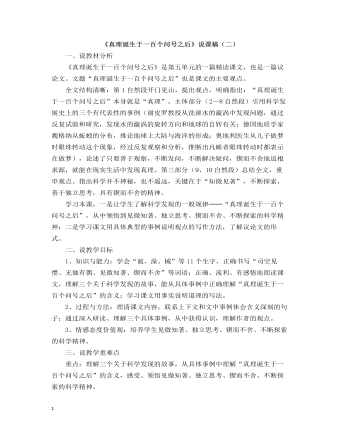
部编人教版六年级下册《真理诞生于一百个问号之后》说课稿(二)
一、说教材分析《真理诞生于一百个问号之后》是第五单元的一篇精读课文,也是一篇议论文。文题“真理诞生于一百个问号之后”也是课文的主要观点。全文结构清晰:第1自然段开门见山,提出观点,明确指出:“真理诞生于一百个问号之后”本身就是“真理”。主体部分(2—8自然段)引用科学发展史上的三个有代表性的事例(谢皮罗教授从洗澡水的漩涡中发现问题,通过反复试验和研究,发现水的漩涡的旋转方向和地球的自转有关;德国地质学家魏格纳从蚯蚓的分布,推论地球上大陆与海洋的形成;奥地利医生从儿子做梦时眼珠转动这个现象,经过反复观察和分析,推断出凡睡者眼珠转动时都表示在做梦),论述了只要善于观察,不断发问,不断解决疑问,锲而不舍地追根求源,就能在现实生活中发现真理。第三部分(9、10自然段)总结全文,重申观点。指出科学并不神秘,也不遥远,关键在于“知微见著”,不断探索,善于独立思考,具有锲而不舍的精神。
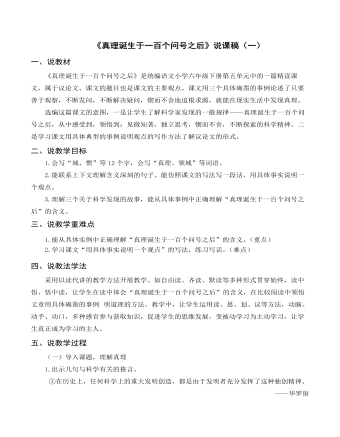
部编人教版六年级下册《真理诞生于一百个问号之后》说课稿(一)
一、说教材《真理诞生于一百个问号之后》是统编语文小学六年级下册第五单元中的一篇精读课文,属于议论文。课文的题目也是课文的主要观点。课文用三个具体确凿的事例论述了只要善于观察,不断发问,不断解决疑问,锲而不舍地追根求源,就能在现实生活中发现真理。 选编这篇课文的意图,一是让学生了解科学家发现的一般规律——真理诞生于一百个问号之后,从中感受到,领悟到:见微知著,独立思考,锲而不舍,不断探索的科学精神。二是学习课文用具体典型的事例说明观点的写作方法了解议论文的形式。二、说教学目标1.会写“域、惯”等12个字,会写“真理、领域”等词语。 2.能联系上下文理解含义深刻的句子。能仿照课文的写法写一段话,用具体事实说明一个观点。 3.理解三个关于科学发现的故事,能从具体事例中正确理解“真理诞生于一百个问号之后”的含义。
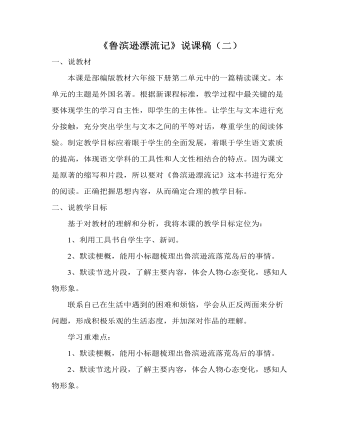
部编人教版六年级下册《鲁滨逊漂流记(节选)》说课稿(二)
四、说学法学生是学习的主体。皮亚杰认为,在教学过程中,儿童如果不具有自己的意象活动教育就不能成功。1、整体感知,初步了解课文的大概内容。学生先自读课文。自学完以后,概括出文章的主要内容。这样,学生就会从整体上知道这篇课文讲的是什么内容。2、充分自学。人的大脑接受信息,有意注意总比无意注意有效得多。本课内容浅显易懂,可以充分放手让学生自学,经过自学,学生对课文有了一个大概了解,有了一番摸索的功夫,或者是略有解悟,或者是不得要领,或者是困惑不解。一旦进入探讨阶段就会全身心投入。一方面可以从容、有条不紊地发表自己的见解;另一方面略有所悟的急需得以印证和深化,不得要领的急需理清头绪,困惑不解的急需弄个明白,自然都格外注意,毫不懈怠。这样既提高了学习兴趣,又留下了深刻印象,还强化了自主意识。
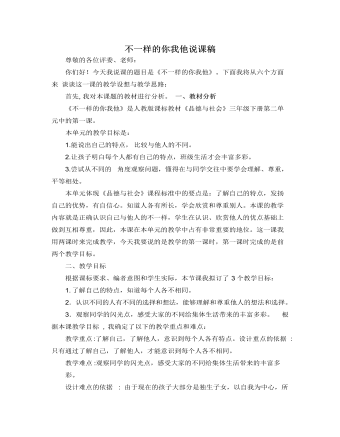
人教部编版道德与法制三年级下册不一样的你我他说课稿
学生画完后,将自己的作品贴在黑板上,并向大家讲述自己的想法。然后引导学生思考并讨论:大家同时在圆上作画,为什么画的不一样?(先由学生小组 讨论,然后学生派代表回答,最后老师引导学生归纳小结)通过大家在圆上作画,让学生知道,不同的人对同一件事情会有不同的想象。从而让学生得出结论:同学们的想法不一样。通过这个环节,激发学生想象,让学生自信并成功自己,欣赏、善待他人。活动三:“我们共同描绘五彩的花束” 我们的班级真是丰富多彩的班级,有着各具特色的你我他,老师很奇怪,如果让大家不同的想法集合在一起会怎么样呢?我们一起来试试吧!小组合作 在同一张纸上给花束上色并给它起一个具有你们小组特色的名字,画完欣赏完 的小组快速把图贴在黑板上。以上三个活动 围绕教学目标展开,每个活动都有目的,三个活动贯穿着逻 辑性,逐步提升。最后我说一说课后延伸环节。
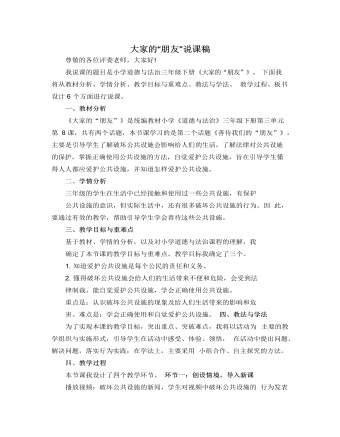
人教部编版道德与法制三年级下册大家的“朋友”说课稿
设计意图:体会公共设施被破坏,给人们的生活带来的不便和危害。活动二:保护我们的“朋友” 首先,课件出示有关破坏公共设施行为处罚的相关法律条文,学生说一说,破坏公共设施会受到怎样的法律制裁。接着,教师列 举一些社会生活中因破坏公共设施而受到法律制裁的事例。然后,课件出示几个公共设施受到损坏的场景,教师引导学生 说一说,该怎么办?并板书。设计意图:知道爱护公共设施是每个公民的责任和义务,破坏 公共设施会受到法律制裁。活动三:善待我们的“朋友”学生阅读教材第 56 页的两幅图片,倾听一些公共设施的“心 声”。然后,课件出示几幅公共设施的图片,学生小组交流这些公共 设施被损坏的原因,讨论文明使用公共设施的金点子。全班交流汇 报,教师相机引导,并板书。
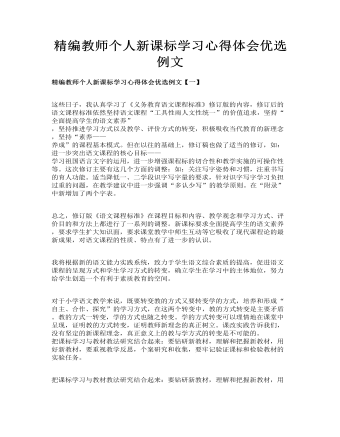
精编教师个人新课标学习心得体会优选例文
我将根据新的语文能力实践系统,致力于学生语文综合素质的提高,促进语文课程的呈现方式和学生学习方式的转变,确立学生在学习中的主体地位,努力给学生创造一个有利于素质教育的空间。 对于小学语文教学来说,既要转变教的方式又要转变学的方式,培养和形成“自主、合作、探究”的学习方式,在这两个转变中,教的方式转变是主要矛盾。教的方式一转变,学的方式也随之转变。学的方式转变可以理情地在课堂中呈现,证明教的方式转变,证明教师新理念的真正树立。课改实践告诉我们,没有坚定的新课程理念,真正意义上的教与学方式的转变是不可能的。把课标学习与教材教法研究结合起来:要钻研新教材,理解和把握新教材,用好新教材,要重视教学反思,个案研究和收集,要牢记验证课标和检验教材的实验任务。
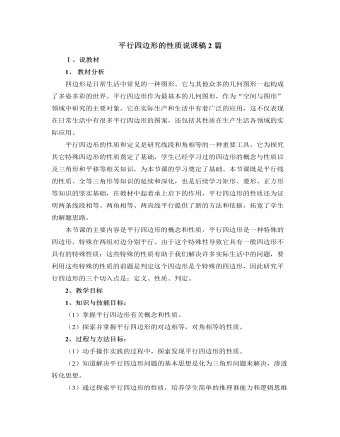
北师大版初中数学八年级下册平行四边形的性质说课稿2篇
注意:平行四边形中对边是指无公共点的边,对角是指不相邻的角,邻边是指有公共端点的边,邻角是指有一条公共边的两个角.而三角形对边是指一个角的对边,对角是指一条边的对角.(教学时要结合图形,让学生认识清楚)设计意图:通过观察图片和回顾以前的知识,使学生由感性认识上升到理性认识。通过描述平行四边形的特点和定义,也培养了学生的语言表达能力。同时也渗透了一些由实际问题转化为数学问题的“转化”的数学思想。(三)、引导实验探索新知【探究】平行四边形是一种特殊的四边形,它除具有四边形的性质和两组对边分别平行外,还有什么特殊的性质呢?我们一起来探究一下.动手操作并思考:让学生根据平行四边形的定义画一个一个平行四边形,观察这个四边形,它除具有四边形的性质和两组对边分别平行外以,它的边和角之间有什么关系?度量一下,是不是和你猜想的一致?

人教版新目标初中英语七年级下册I ’d like some noodles教案
教学过程Step 1: warming-up Sing a song---------“food and drink” Step 2: Revision1 Dictation2 Revise: What kind of noodles would you like?I’d like …What size bowl of noodles would you like?I’d like…Step 3: Presentation1 show pictures of food, ask students say the words.2 Students read the newspaper ad in 3a. Fill in blanks with words in the box. Then read the ad together, the teacher explains some difficult language points.3 Check the answers Step 4 PracticeAsk students to finish 3b in the same way according to 3a. Students read the short passage and fill in the blanks .At last, check the answers.Step 5 productionAsk students to write their own ad for dumplings, noodles, drinks, and other foods they know. Then ask students to read their partner’s ad. Then order food and drink from their partner.Step 6 Home workGroup work – make an ad about “food and drink”

人教版新目标初中英语七年级下册Where did you go on vacation教案
句型: Where did you go on vacation? I went to summer camp.Did she go to Central Park?Yes,she did.No, she didn’t语法:一般过去时特殊疑问句、一般疑问句及肯、否定回答。课时安排4课时第一课时:Section A:la,1b,lc,2a,2b,2c 第二课时:Section A:3a,3b,4第三课时:Section B:1,2a,2b,2c第四课时:Section B:3a,3b,3c,4 and Self Check第一课时教学目标掌握描写假期生活的形容词。假期里自己所做事情的简单表达。谈论假期做的事情及当时情况。谈论假期时旅游的天气,旅游者以及食物等。教学过程一、导入播放一首英文歌曲:Let’s travel 说明:通过让学生听节奏欢快迪斯尼英语歌曲Let’s travel.引入本节课谈论的话题vacation and travel. 让歌曲使学生的思维活跃,增强课堂气氛,激发学生提高学习英语的兴趣。T:How is the trip ?Ss : It’s pretty good/ happy/exciting /relaxing/busy/dangerous/ fantastic说明:这个问题是为了操练形容词。建议让多个Ss作答。鼓励他们用不同的形容词。上述个别形容词本应在第二课时中出现,但可以在warming-up中第一次非正式出现。这些形容词也可在老师的评价语中适时出现,以加深学生对词汇的印象。

人教版新目标初中英语七年级下册Where is your pen pal from教案
2.1Match the country with the language.Step II Reading3a? let the students read the letter fast and answer the questions.? Let the students ask more questions about the letter as possible as the can.Step III Writing3b.Step IV. Pairwork2cStep V Listening2a, 2bStep V. HomeworkExercises book(1) P3Exercises book (2) P3Period FourStep I . Dictate the words and sentences in Unit1.Step II. Self-checkStep III. Check the answers for Exercises book in the unit.Step IV. Home workRevise and preparation for unit 2.教学反思:通过本单元的学习,学生基本可以谈论人们的国籍,居住城市及其所说的语言,通过书信方式去介绍自己并寻找笔友。但在涉及到国外的一些城市时,学生对这方面的知识相对欠缺,能介绍的城市并不多,也反应出学生课前预习不充分,这跟学生学习条件也有关,大多数学生无法通过网络获取所需信息。因此,在以后的教学中要多指导学生通过计算机网络获取信息,拓宽知识面。

人教版新目标初中英语七年级下册What do you think of game shows教案
五、教学Section B-2c1. Pair work: What do you think of the belt/sunglasses/…? What does your father/mother/… think of your scarf/belt…?2. Group work(1). Teacher shows some different kinds of school uniforms (制服)and asks : “ What do you think of your school uniforms? If you have a chance to choose your school uniforms, what kind would you like to choose?”(2). Discuss in groups.(3).Get some Ss to report in class.说明:这一步旨在让学生运用已有的语言知识谈论对事物的看法和意见,并简单阐明理由,培养学生的主动思维能力和运用英语的能力。六、教学拓展调查电视节目的收视率任务:调查你周围的人对现在各种电视节目的反响。活动过程:1.教师布置任务,让学生调查周围的人(包括他的亲戚朋友和邻居)喜欢收看哪方面的电视节目。2.学生进行调查活动,运用本单元所学的句型What do you think of….? (Why?)What's your favorite game shows?What do you think of talk show?I doesn’t mind it.I like it.I love it.I can’t stand it.3.记录下排在前10位的TV Program,填写调查表,比较其收视率。

人教版新目标初中英语八年级下册Have you ever been to an amusement park教案
(1)Have you ever been to …? Yes, I have. / Yes, I have ever been to …No, I haven’t. / No, I have never been to …(2)When did you go there? I went there last year. (3)I have never been to a water park. Neither have I. I have ever been to an amusement park. So have I. (4)How long have you been studying English? I’ve been studying English since nine o’clock. I’ve been studying English since I came back home. I’ve been studying English for five hours. (5)What’s that? It’s an amusement park in Japan. I’ve never been to an amusement park like it before. It’s fun to learn another language. Let’s go tonight. Isn’t this great?space museum, amusement park, water park, South America, Peru, Holland, European culture, tour guide, flight attendant, musical instrument, more than, be from, get to, take lessons, neither, discover, graduate, change

人教版新目标初中英语八年级下册Would you mind turning down the music教案
Step 4. Group work (4)1. Ask a pair of students to read the dialogue. Say, This activity provides speaking, listening and writing practice using the target language.2. Ask students to complete the work in groups.3. Check the answers with the whole class. 4. Explain some of the language points. Step 5. Word review (Self check 1)1. Ask students to read the words and the phrases given. 2. Fill in the blanks with proper forms of these words to complete the sentences. 3. Check the answers with the whole class. Homework:Do activity 2 on page 57 after class. Period 6Teaching aims: 1. Teach vocabulary words and the useful expressions. 2. Enable the students to learn etiquette in different culture. 3. Help the students learn how to behave politely in public places and in daily life. Teaching procedures:Step 1. RevisionHelp students to review the function of making requests through a free talk. Then lead them to the topic of etiquette. Explain the meaning of etiquette. Or, ask students to look it up in the dictionary. Step 2. Pre-reading (Section 1)1. Ask students to read the picture and make a list with their partner about how many rules of etiquette can be seen being broken.

人教版新目标初中英语九年级下册By the time I got outside, the bus had already left教案
Ⅰ. Teaching Aims and Demands1. Knowledge Objects(1) Key Vocabularyoversleep(2) Target LanguageWhat happened?I overslept. And by the time I got up, my brother had already gotten in the shower.2. Ability Objects(1) Teach the students to use the new words.(2) Train the students to narrate past events with the Past Perfect Tense.(3) Train the students' listening and speaking skills with the target language.3. Moral ObjectIt’s a good habit to go to bed early in the evening and get up early in the morning. So you’ll never be in a hurry in the morning.Ⅱ. Teaching Key Points1. Key Vocabularyoversleep2. Target LanguageNarrate past events with the Past Perfect TenseⅢ. Teaching Difficult Points1. Train the students to narrate past events with the Past Perfect Tense.2. Train the students to understand the target language in spoken conversation.Ⅳ. Teaching Methods1. Thinking of examples from the students' real lives.2. Making sentences by looking at the pictures.Ⅴ. Teaching AidA tape recorderⅥ. Teaching ProceduresStep I Revision1. Revise the language points in Unit 8.Ask some questions like this: What volunteer work would you like to do?Help the students to answer, I’d like to…/I love to…/I hope to2. Practice the dialogue in Activity 3c on page 62 again. Get students to role play the similar dialogues with the following.

人教版新目标初中英语九年级下册Rainy days make me sad教案
1. 教材分析本单元以how do things affect you?为话题, 从颜色、天气、音乐、广告、产品等方面谈论了外界事物如何影响人的心情。要求学生掌握表达某物或某事给人带来的感觉、看法或影响等。共设计了四个部分的内容:Section A 该部分有4个模块:第一模块围绕Which restaurant would you like to go to?这一话题展开思维(1a)、听力(1b)、口语(1c)训练;第二模块围绕How does music affect you? 进行听力(2a-2b)、口语训练(2c);第三模块继续围绕how do colors in the restaurant affect you这一话题展开训练,训练形式为阅读和问题体验(3a)和小组活动(3b);第四模块仍就How do things affect you这一话题以调查的形式展开讨论。Section B该部分有4个模块:第一模块围绕产品广告对人们的影响这一话题以“配对”(1a)与“列举”(1b)两种形式展开训练;第二模块继续围绕How do things affect you? 进行听力(2a-2b)、口语对话训练(2c);第三模块围绕“Advertising”这一话题展开阅读(3a-3b)和写作(3c)训练;第四模块围绕How posters affect you这一话题以口语训练形式展开小组活动。

人教版新目标初中英语九年级下册Could you please tell me where the restrooms are教案
Step Ⅰ RevisionCheck homework. Ask a few students to read the article in 3a.Then ask a few students to read their guides.Step Ⅱ Part 1Look at the words in the box. Ask a student to read them. Make sure the students understand the meaning of the words. You are to fill in the blanks with the words. In some cases, students may need to use another form of the word, for example adjusting for tense or subject/ verb agreement.Ask students to fill in the blanks on their own.Check the answers. Step ⅢPart 2Go through the instructions with the class.Look at the example with the students.Ask students what the answer would be.Ask a student to read the question and answer it.Excuse me, could you tell me where the bank is, please?The bank is across the street from the shopping malt.Get students to complete the work in pairs.Check the answers. Ask a few students to read their questions.Step Ⅳ Just for Fun!Ask all the students to read the conversation. Ask: What is funny about this cartoon? Help students to explain. A Martian is a person from the planet Mars.There is no such thing as Martian food on Earth, and the clerk looks silly because he is trying to think of where there is a Martian restaurant.Invite some pairs of students to present this conversation to the rest of the class.Step Ⅴ Summary and HomeworkIn this class, we’ve done much writing practice using the key vocabulary words and the target language presented in this unit. After class, please finish the questions in 2 in your exercise books. Then finish the exercises on pages 47~48 of the workbook as well.The Seventh Period Ⅰ Teaching Aims and Demands1. Knowledge Objects(1) Key Vocabularyimage, adventure, jealousy, hero, crime, journey, brave, no longer, show interest in, take it easy, become interested in, plain looks(2)Text:Grown-ups like cartoons, too.2. Ability Objects(1) Fast-reading to get a general idea of the text.(2) Careful-reading to get the detailed information in the text.

人教版新目标初中英语九年级下册I’ll help clean up the city parks教案
Talk about offering help (P60)I’ll help clean up the city parks.A: I’d like to work ...B: You could help ...Talk about ways to tell people about the Clean-Up Day (P61)We need to ...We can’t ...I’ll ...Talk about the work the volunteers do (P62)These three students all volunteer their time to help other people.Somebody loves to ... / helps ... / plans to ... / wants to ...A: What do you like doing?B: I like ... A: What kind of volunteer work do you think I could do?B: You could ...1. 重点词汇advertisement, fix, repair, pleasure, blind, deaf, shut, carry, specially, fetch2. 认读词汇hunger, homeless, cheer, clean-up, sign, establish, major, commitment, elementary, veterinarian, coach, similar, call-in, strategy, disabled, organization, unable, support, appreciate, donation, part of speech, pronoun, adverb, preposition, conjunction, donate, Jimmy, Sally3. 词组clean up, cheer up, give out, put off, set up, think up, take after, fix up, give away, put up, hand out, work out, at once

人教版新目标初中英语九年级下册You’re supposed to shake hands教案
教学目标:1. 掌握本单元一些重点词汇的写法和用法。2. 学会自如谈论餐桌礼仪。Step 1 RevisionAsk some students to retell the customs at the table in France in the passage in 3a.Step 2 Self checkPart 1. Fill in each bland with the correct word given. Students do the exercises by themselves at first. Then check the answers. Ask the students to comprehend the sentences and help them point out uses of some words, like “arrive (at / in) sw., spend time / money on sth , spend time / money (in) doing sth.”Part 2. Read about Fan Ling’s experience in a western restaurant. Understand the passage. Point out some key points in the passage.1. be / get used to doing sth. 习惯做某事2. begin with = start with 以….开头3. crowd v. 挤满,塞满 the crowd 人群 crowded adj. 拥挤的Then students discuss about how she would solve her problem. Ask some to share their stories with others.Part 3. Complete the crossword by looking at the sentences on the left. Then check the answers.
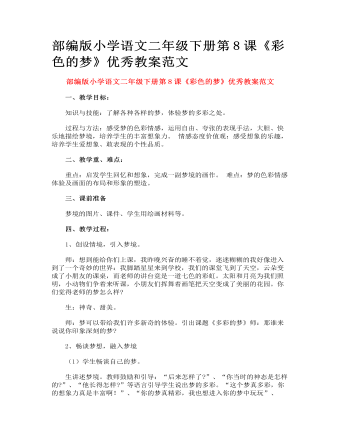
部编版小学语文二年级下册第8课《彩色的梦》优秀教案范文
创设情境,引入梦境。师:想到能给你们上课,我昨晚兴奋的睡不着觉,迷迷糊糊的我好像进入到了一个奇妙的世界:我脚踏星星来到学校,我们的课堂飞到了天空,云朵变成了小朋友的课桌,而老师的讲台竟是一道七色的彩虹。太阳和月亮为我们照明,小动物们争着来听课,小朋友们挥舞着画笔把天空变成了美丽的花园。你们觉得老师的梦怎么样?生:神奇、甜美。师:梦可以带给我们许多新奇的体验。引出课题《多彩的梦》师:那谁来说说你印象深刻的梦?
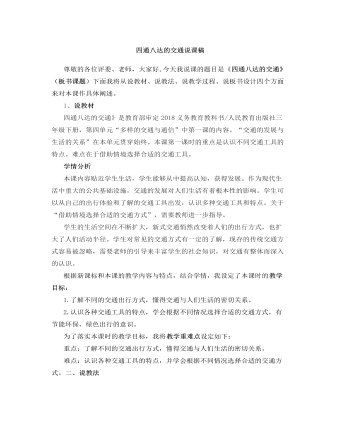
人教部编版道德与法制三年级下册四通八达的交通说课稿
1.宇涵同学音频说出自己出行困扰。2.小组合作讨论设计往返旅游线路:宇涵同学渴望大家的帮助,就请小组成员一起合作,帮宇涵设计一份往返旅游线路,我这里有一份从南京到大连的不同交通工具所需时间及费用的参考表。小组讨论,并将小组一致认为最适合的设计方案,写在设计表中!3.各小组派代表分享设计方案4.设置情境,学以致用:同学们设计的方案都很好,如果从我们目前所在的城市,到宇涵的家乡“南京”你又会如何选择?5.小结:看来,同学们都能根据自己不同的需求选择合适的出行方式。活动二:了解传统交通方式的作用1.观察思考:在我国,一些地区至今还沿用着传统的交通工具(出图),大家仔细观察,想一想,为什么它们能沿用至今?你还知道哪些传统的交通工具?2.小结:是呀,无论时代如何变迁,现代交通工具多么发达,都要选择适合我们的交通工具。在享受它们带来的便捷时,做到绿色出行,减少拥堵污染,那我们的生活一定会更加美好。

